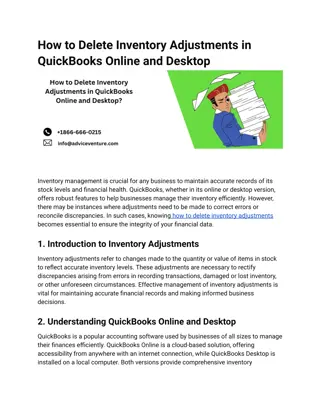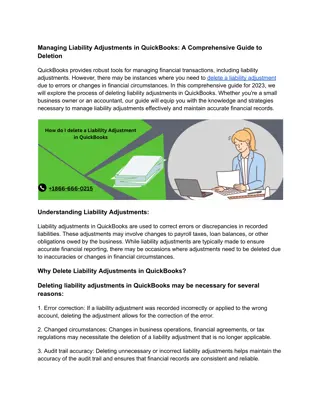
Risk Adjustment for Socioeconomic Status in Healthcare Measurement
Explore the significance of risk adjustment for socioeconomic status in healthcare performance measurement, including considerations for addressing disparities and unintended effects. Learn about the recommendations for adjusting outcome measures and the importance of including sociodemographic factors in performance scoring.
Download Presentation

Please find below an Image/Link to download the presentation.
The content on the website is provided AS IS for your information and personal use only. It may not be sold, licensed, or shared on other websites without obtaining consent from the author. If you encounter any issues during the download, it is possible that the publisher has removed the file from their server.
You are allowed to download the files provided on this website for personal or commercial use, subject to the condition that they are used lawfully. All files are the property of their respective owners.
The content on the website is provided AS IS for your information and personal use only. It may not be sold, licensed, or shared on other websites without obtaining consent from the author.
E N D
Presentation Transcript
D I S C E R N R i s k A d j u s t m e n t f o r S o c i o e c o n o m i c S t a t u s ; L i n k i n g C o s t a n d Q u a l i t y M e a s u r e s HSCRC Performance Measurement Workgroup May 28, 2014 Discern Health Discern Health 1120 North Charles Street 1120 North Charles Street Suite Suite 200 MD 21201 21201 200 Baltimore, Baltimore, MD (410) 542 (410) 542- -4470 www.discernhealth.com www.discernhealth.com 4470 Tom Valuck, MD, JD
D I S C E R N Presentation Overview Update the Performance Measurement Workgroup on NQF activities related to two measurement issues raised in previous workgroup deliberations Risk Adjustment for Socioeconomic Status or Other Sociodemographic Factors Public comment draft published March 2014; final report in development Linking Quality and Cost Indicators to Measure Efficiency in Healthcare Public comment draft published April 2014 2
D I S C E R N Risk Adjustment for Socioeconomic Status and Other Sociodemographic Factors 3
D I S C E R N Clinical vs. Socioeconomic Risk Current NQF policy: Recommends the adjustment of outcome measures for clinical factors, such as severity of illness and co-morbidities, recognizing that patients who are sicker and have multiple conditions have a higher likelihood of worse outcomes, regardless of the quality of care provided Does not allow adjustment for sociodemographic factors to make disparities visible; rather, recommends that measures be stratified by the relevant factors 4
D I S C E R N Clinical vs. Sociodemographic Risk Adjustment for sociodemographic factors may be appropriate to avoid undesirable unintended effects Adverse selection providers avoiding disadvantaged populations Shifting performance-based payments and market share away from providers that serve disadvantaged populations, resulting in fewer resources to treat those populations 5
D I S C E R N Draft Recommendation Appropriate adjustment depends on the purpose of measurement For purposes of accountability (e.g., public reporting, performance-based payment), sociodemographic factors should be included in risk adjustment of the performance score For purposes of identifying and reducing disparities, performance measures should be stratified on the basis of relevant sociodemographic factors 6
D I S C E R N Risk Factors Socioeconomic Status Income (or proxy based on residence) Education Occupation/employment Community-level variables, such as: Distance to healthcare providers and pharmacies Access to food outlets and parks Transportation Neighbors, social support infrastructure Crime rates 7
D I S C E R N Risk Factors Demographic factors related to socioeconomic status and/or clinical outcomes: Insurance status Race and ethnicity English language proficiency Homelessness Marital status Literacy/health literacy 8
D I S C E R N Stratification for Identifying Disparities Patient populations are grouped (stratified) by sociodemographic indicators and their measured outcomes are evaluated for each group Upside- Makes demographic disparities evident, and results in groups of patients that can be compared across providers Downside- Does not lead to an obvious overall score for financial incentives; groups across providers may have different sample sizes, making comparisons questionable 9
D I S C E R N Using Peer Groups as an Alternative Make comparisons within peer groups of providers with similar resources and similar populations Upside- Performance scores would not need to be adjusted to compare quality outcomes Downside- Disparities not identified; hard to evaluate across peer groups 10
D I S C E R N Public Comments on Draft Report Providers Sociodemographic risk adjustment is essential for fairness Necessary to avoid undesirable unintended effects for vulnerable populations and the providers that care for them Consumers and Purchasers Sociodemographic adjustment might mask quality problems or disparities; could promote using different clinical standards for different patients Unclear if there is enough evidence that, without risk adjustment, there is the potential of harm for patients 11
D I S C E R N Other Notes Regarding Adjustment for Socioeconomic Status No absolutes- Each measure should be considered for the appropriateness of risk adjustment For example, central line infections or wrong site surgery should not be adjusted Access to good sociodemographic data a barrier Stratification, risk adjustment, and peer grouping are not mutually exclusive methods- consider hybrid approaches 12
D I S C E R N Linking Quality and Cost Indicators to Measure Efficiency 13
D I S C E R N Linking Quality and Cost Indicators Commissioned paper authors performed an environmental scan to identify methods that combine quality and cost measures to assess efficiency Identified 7 proposed or currently-used approaches No definitive approach in use 14
D I S C E R N What Is Efficiency? Relationship between inputs and outputs Efficiency = quality / costs Can increase efficiency by increasing quality, decreasing costs, or both; but cheaper is not necessarily more efficient To measure efficiency, need both the quality and cost components 15
D I S C E R N Approaches to Assessing Efficiency Conditional Model Quality assessed with a single measure or a composite measure Cost assessed, typically with a measure of total cost Quality and cost domains classified into performance groups, frequently low, medium, and high Classifications combined to assess efficiency (e.g., high quality, medium cost; low quality, high cost) 1. 2. 3. 4. 16
D I S C E R N Variations of the Conditional Model Hurdle Model Minimum quality standard must be met before cost is assessed, or vice versa Unconditional Model Unconditional Model Quality and cost are assessed independently, and then quality and cost domains are assigned different weights and combined into a single measure Side Side- -by by- -Side Comparison Model Side Comparison Model Quality and cost are evaluated but not combined, leaving the standalone values for comparison 17
D I S C E R N Other Approaches to Assessing Efficiency Regression Model Uses regression analysis to account for within- provider correlation between quality and cost outcomes Cost Cost- -Effectiveness Model Effectiveness Model Assigns dollar amounts to quality outcomes (like increased survival) so that outcomes may be compared in financial terms Data Envelopment Analysis Model Data Envelopment Analysis Model Develops a continuous efficiency frontier against which all quality and cost results are compared 18
D I S C E R N Use of Efficiency Assessment Models Method Current Use Conditional Wide use among private payers to tier providers based on efficiency Hurdle Used in shared savings programs Unconditional Used in Hospital Value-Based Purchasing and Leapfrog Recognition Program Side-by-Side Used in Medicare Star Ratings and NCQA Relative Resource Use Regression Health services research Cost-Effectiveness Health services research Data Envelopment Health services research 19
D I S C E R N Approaches to Assessing Efficiency Considerations Conditional, Unconditional, Side-by Side, and Hurdle models are easier to understand and more transparent, but they depend on measure weighting mechanisms that may undermine validity In all models, if relationship to outcomes and actual patient health is not well defined, then promoting measure compliance might not actually yield efficiency gains Cost and quality measures are often not harmonized across timeframes, patient populations/denominators, or price Virtually no assessment of the reliability and validity of these models 20
D I S C E R N Thank You 21

![Read⚡ebook✔[PDF] Linking the Space Shuttle and Space Stations: Early Docking Te](/thumb/21519/read-ebook-pdf-linking-the-space-shuttle-and-space-stations-early-docking-te.jpg)




















